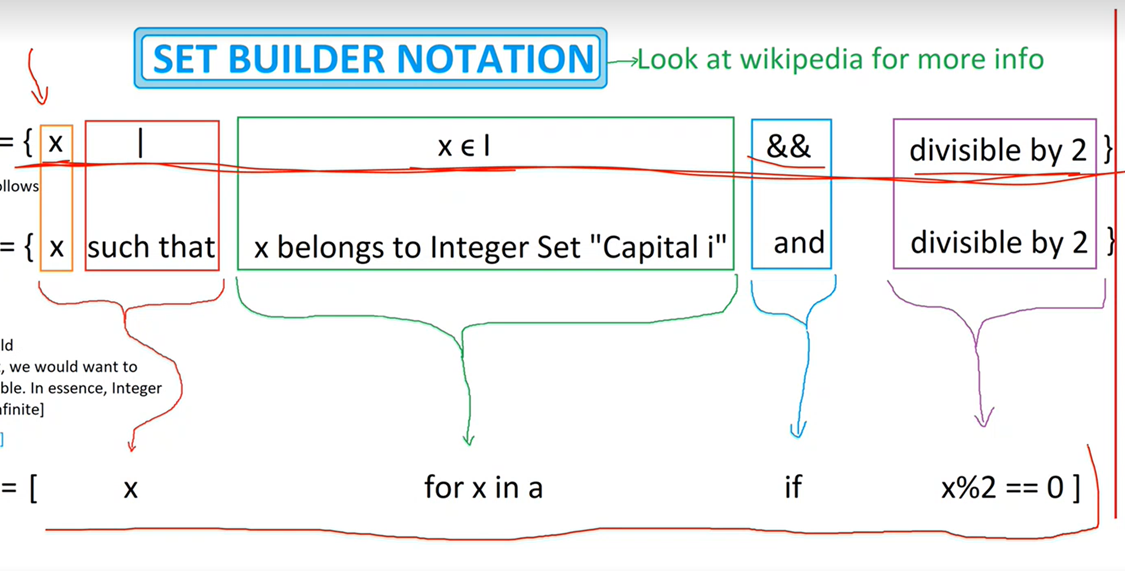List
Dec 6 2021
4 min read

List Iteration, List Splicing and List Comprehension [alias, Set Builder Notation in code format]
-
1) Everything is object based. Even basic data types like (int, float…etc) are also objects.
we can get the type of object by using type() function.
Example:a = 10 type(a) -> class 'int' , gives the class type - 2) We can convert one type to other type by using conversion function like int(), float(), str().. etc
- 3) Every object has an id. We can get the id of any object by using “id(object)”.
-
4) Python is also reference based. We need to use “id()” to check objects are pointing to same data.
Example :
a = 10 b = 10 if id(a) == id(b): #checks if id of a is same as id of b -
5) We can also override the predefined function to our requirement. We need to be careful whether we want it or not.
Example:
print(“Hello”) #here print is a predefined function print = 10 # here print is a int variable. -
6) If we want to restore the functionality of the print without restarting the session. One simple way is to delete the “print” variable using “del”.
Example:
del print -
7) Initialize an list by using “[ ]”
Example:
a = [] #empty list b = [1,2,3,4] -
8) Some basic operations on list:
list Slicing:
a = [1,2,3,4,5,6] #Initializing the list b = [[1,2,3],4,5,[6,7,8,]] # nested list Initializing b = a # reference of a to b c = a.copy() #coping the list a.append(7) #appending the element a.extend([8,9,10,11]) #extend the list by appending another listSet Builder notation:a = [1,2,3,4,5,6,7,8,9] b = a[0:5:2] # here 0 is start index # 5 is end index # 2, increment count now b will be having [1,3,5] we can use above step for copying the lists b = a[:] # we are not giving any arguments here, default it will take entire range # now b will have copy of the same list as a
Example:
a = [1,2,3,4,5,6,7,8,9] b = [x for x in a] # here it will copy all the elements of a b -> [1,2,3,4,5,6,7,8,9] b = [x for x in a if x%2 == 0] # here it will have even numbers of a. because of the condition. b -> [2,4,6,8] b = [2*x for x in a if x%2 == 0] # here its same as above. But all even values will be doubled and placed in b b -> [4,8,12,16]Refer the video for explanation
-
9) Adding Temp path variable in python:
import sys sys.path -> gives the path data which is present in environment path in a list sys.path.append(“D:/pythonLibs”) #adds the path given here to the python session. Which is temporary and limited to the session. - 10) by default, there is a reserved python environment variable "PYTHONPATH". where we can add all the path locations, those will be included by default and we can use them by importing directly.
Assignment:
with open(r"D:\temp\myTet.stl") as f:
p, area, vol = [],0, 0
for i in f.readlines():
if 'normal' in i or 'vertex' in i:
p.append([float(x) for x in i.split()[-3:]])
if len(p)%4 == 0:
n, v1, v2, v3 = p
a = ((v1[0]-v2[0])**2+(v1[1]-v2[1])**2+(v1[2]-v2[2])**2)**0.5
b = ((v1[0]-v3[0])**2+(v1[1]-v3[1])**2+(v1[2]-v3[2])**2)**0.5
c = ((v3[0]-v2[0])**2+(v3[1]-v2[1])**2+(v3[2]-v2[2])**2)**0.5
s = (a+b+c)/2.0
ap = [sum(v)/3 for v in zip(v1, v2, v3)] # calculating centroid of the triangle
da = (s * (s-a) * (s-b) * (s-c))**0.5 # small area
area = area + da
vol = vol + (ap[0]*n[0]+ap[1]*n[1]+ap[2]*n[2])*da/3 # gauss divergence theorem
# Field vector taken is xi + yj + zk, whose divergence is a scalar 3.
p.clear()
print(area, vol)